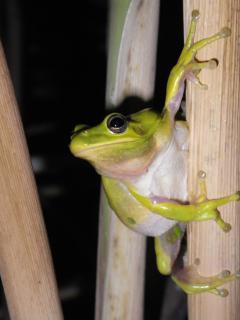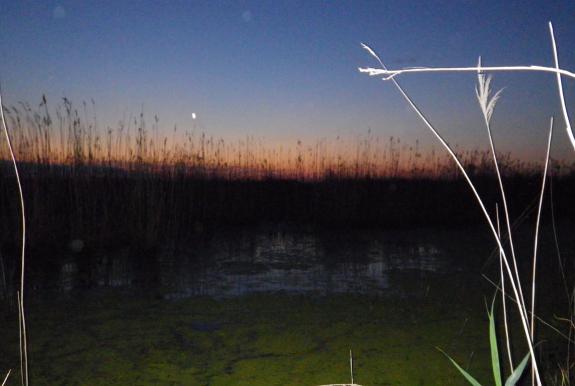Green treefrogs
In June 2011, a breeding population of green treefrogs, Hyla cinerea, was discovered in New Jersey. This was the first documented occurence of this species in New Jersey.
 Zoom+ American green treefrog © Karena DiLeo
Zoom+ American green treefrog © Karena DiLeo
Green treefrogs, Hyla cinerea, are abundant across their geographic range, from the Delmarva Peninsula south along the Atlantic Coastal Plain to Florida, westward along the Gulf Coastal Plain to eastern Texas, and extending north in the Mississippi River Valley to southern Illinois (Aresco 1996). In June 2011, a large, breeding population of green treefrogs was discovered in freshwater tidal marsh in southwestern New Jersey along the Delaware River. This was the first recorded occurrence of green treefrogs in New Jersey and represents a possible range expansion past their northern-most limit in Delaware. Since this documented occurrence, subsequent reports of this species have been confirmed along the Delaware Bayshore in Salem and Cumberland Counties.
Range expansions are not uncommon in green treefrogs. Both natural range expansions and introduced populations of have been reported across the eastern and central United States and Puerto Rico. Human-introduced populations have been linked to the pet trade, fish farms, and aquatic plant sales, but few of these populations become established (Somma 2012). Natural range expansions have been documented in southern Illinois as populations appear to be moving northward (Redmer et al 1999, Tucker et al 2008). Although the origin of this introduction is unknown, rising temperatures in Illinois, 1.2°C per decade since 1970, may have allowed the treefrogs to survive the winters and reach detectable levels (Tucker et al 2008).
 Freshwater tidal marsh used by green treefrogs for breeding (c) Karena DiLeo
Freshwater tidal marsh used by green treefrogs for breeding (c) Karena DiLeo
CWF and Montclair State University are working to determine the origin of the New Jersey population using genetic analysis. By comparing mitochondrial DNA from New Jersey frogs and Delaware frogs with museum specimens from other states, we hope to determine if this new population was established via range expansion from Delaware. Preliminary results indicate that these two populations are very closely related and this relationship is most likely a result of a recent movement of Delaware frogs to New Jersey. Although this movement may have been human-mediated, rising temperatures throughout the eastern and central US are possibly favoring the persistence and establishment of these frogs in new areas.




